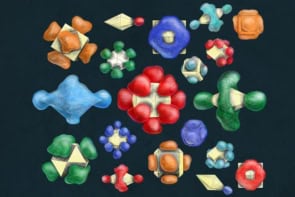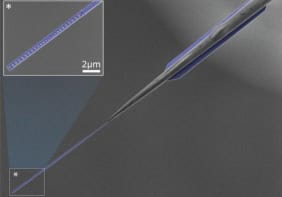A long-standing controversy about why tiny silicon crystals emit light appears to have been settled by a clever experiment that pins down the movements of electrons in the material. The work was done by researchers in Europe and reveals that one of two distinct effects is involved in producing the light — depending on the structure of the nanocrystals. This information could help in the development of silicon-based optical devices, which have hitherto been very difficult to make.
Silicon’s wonderful electronic properties mean that just about every high-tech gadget contains devices made from the semiconductor material. However, silicon is notoriously bad when it comes to creating or processing light, which is why other semiconductors such as gallium arsenide are used in optical devices such as light-emitting diodes (LEDs) or switches for optical communications networks.
Indirect band gap
Silicon’s optical inadequacies are related to an “indirect” gap between its electron energy bands, which makes it very difficult for an electron to jump directly from the conduction band to the valence band by simply emitting one photon.
One glimmer of hope for those pursuing silicon-based optical devices is that nanometre-sized crystals of silicon are known to emit light in a process called photoluminescence — something that is not seen in larger bulk samples. But exactly how and why this process occurs in tiny bits of silicon had been a hotly contested issue since the effect was first seen in porous silicon in 1990.
Defects or confinement?
Experiments done by several groups suggest two distinct possibilities: structural defects and quantum confinement. Defects are thought to change the energy bands of the silicon, making it easier for electrons to move between energy levels by emitting light. Quantum confinement arises because the size of the nanocrystals is on par with the wavelength of the electrons — which also modifies the energy bands. Light from defects and light from quantum confinement normally looks very similar, which had made it difficult to work out which effect was responsible for photoluminescence.
Now, Manus Hayne of the University of Lancaster in the UK and colleagues in the Netherlands, Germany and Belgium have shown that when defects are present, they are responsible for nearly all of the light emission — but if there are no defects, the light is a result of quantum confinement Nature Nanotechnology doi:10.1038/nnano.2008.7).
Squeezing electrons
To do this the team made their photoluminescence measurements in a strong magnetic field. The field “squeezes” the electrons, which confines their motion to a “magnetic length”, which is dependent on the field strength
Confinement is also a feature of defects, from which conduction electrons stray no further than 1 nm. By contrast, quantum confinement occurs on length scales comparable to the size of the nanocrystal — about 3–5 nm in Hayne’s experiment.
If a field (about 50 T) with a magnetic length between 1 and 3 nm is applied to the nanocrystals, electrons associated with quantum confinement will be squeezed — causing a tiny shift in the wavelength of the light emitted — but electrons associated with defects are largely unaffected.
One or the other
When such a field was applied to nanocrystals that were known to have lots of defects, no shift in the light was seen — suggesting that the photoluminescence is associated with defects. The team then removed the defects by heating the nanocrystals in pure hydrogen and again applied the magnetic field. This time they saw a clear shift in the wavelength of the emitted light — proof that quantum confinement was responsible for the photoluminescence. Finally, the hydrogen was removed by heating the nanocrystals in vacuum — which brought back the defects. And sure enough, the wavelength shift vanished.
So does Hayne think that these experiments will put a stop to the controversy? “We think that using a magnetic field is a pretty definitive test, but the answer could vary from sample to sample,” he said.
According to Hayne, understanding the underlying mechanisms for light emission is crucial for researchers who are attempting to make efficient light-emitting devices from silicon. “Even from silicon nanocrystals the luminescence is not very bright, compared to nanostructures made from compound semiconductors, for example,” Hayne told optics.org. “It is very important to understand where the light is coming from if you want to improve the efficiency.”



